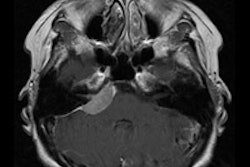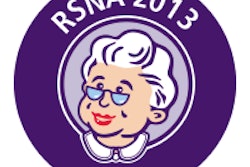Fewer than 1% of incidental pulmonary nodules on abdominal CT turn out to be malignant; however, the odds of catching these rare lung cancers could be improved by using clinical decision-support software when recommending follow-up imaging, according to research from Massachusetts General Hospital (MGH).
After the institution adopted a Web-based clinical decision-support tool for these pulmonary nodules, concordance of imaging recommendations with MGH radiology department guidelines increased from 50% to 96% among the patients for whom it was used.
"A point-of-care decision-support tool improves adherence to recommendations for follow-up of incidental lung nodules," said Dr. Michael Lu. "This may have an impact on cost and patient outcomes."
Lu reported the team's findings during a scientific session at RSNA 2013.
Improving adherence to guidelines
MGH's department guidelines for follow-up imaging of these incidental lung nodules are based on Fleischner Society criteria. These guidelines were posted all over the radiology department to ensure consistent recommendations, but adherence hasn't always been consistent, according to Lu.
"One potential solution is to use a clinical decision-support system," he said. "This can overcome guideline fatigue, improving consistency of recommendations."
In the fall of 2012, the institution implemented Ditsel, an MGH-developed point-of-care clinical decision-support tool for radiologists for lung nodules seen on abdominal CT. The application incorporates the department's guidelines based on nodule size, and it provides text for the recommended imaging study directly into the body of the radiology report. Ditsel is accessible through an icon on the radiologist dashboard at every speech recognition workstation.
The researchers sought to test their hypothesis that Ditsel would improve concordance with the department guidelines. In the retrospective, single-center cohort study, the team included all adults with solid, noncalcified lung nodules on abdominal CT. Because the researchers wanted to focus on cases in which the abdominal radiologist was responsible for finding the incidental nodule, they excluded cases that did not have a prior abdominal CT or had a prior/concurrent chest CT study, Lu said.
A group of 268 patients were included as historical controls from a period (January 1, 2012, to October 21, 2012) prior to implementation of the system. After clinical decision support was implemented for incidental lung nodules on abdominal CT and radiologists were encouraged to use the tool, the researchers assessed the results in a period from October 22, 2012, to April 4, 2013. This group included 141 qualifying patients.
The researchers manually reviewed CT reports and electronic medical records to determine several factors:
- Size of the largest nodule
- Any malignancy within the past five years
- If the patient smoked
- Whether clinical decision support was used
- Follow-up recommendations
They then calculated the concordance of imaging follow-up recommendations with department guidelines in historical controls, compared with concordance after the implementation of clinical decision support.
Improved concordance
The researchers found that after Ditsel was implemented, adherence to the department's guidelines went from 50% to 65% (p = 0.0036). The tool was used in 40% (57/141) of the patients after the technology was adopted, they also noted.
Delving deeper into the data, the researchers found that Ditsel's value really stood out in the cases in which it was used. Concordance with department guidelines increased to 96% among these patients, compared with concordance of 45% in cases in which the tool was not used, despite being available. This compares to a concordance of 50% in the period before Ditsel was adopted.
| Ditsel's impact on lung nodule guideline adherence | |||
| Before Ditsel adoption (control group) | Ditsel available but not utilized | Ditsel available and utilized | |
| Recommendations concordant with guidelines | 50% | 45% | 96% |
| No CT recommended when indicated | 23% | 29% | 0 |
| Follow-up CT recommended too early | 17% | 14% | 4% |
| CT recommended when not indicated | 6% | 5% | 2% |
| Follow-up CT recommended too late | 5% | 7% | 0 |
The use of clinical decision support offered a statistically significant improvement (p = 0.0001) in concordance with guidelines, compared with both the historical controls and the patients for which clinical decision support was available but not utilized.
Lu acknowledged a number of limitations to the research. The study was not randomized, and concordance with guidelines was the outcome measure, not whether the follow-up was actually performed or the eventual clinical outcome, he said.
"We continue to collect data, and we want to see whether the usage rate of Ditsel increases over time," he said. "The other thing we would like to see [is] if there's a learning effect [from the use of Ditsel]."
Nonetheless, the researchers concluded that a point-of-care clinical decision-support tool improved adherence to guidelines for radiology recommendations for follow-up of incidental pulmonary nodules, Lu said.
The decision-support tool will also be rolled out for other radiology sections such as the chest, he said.



















